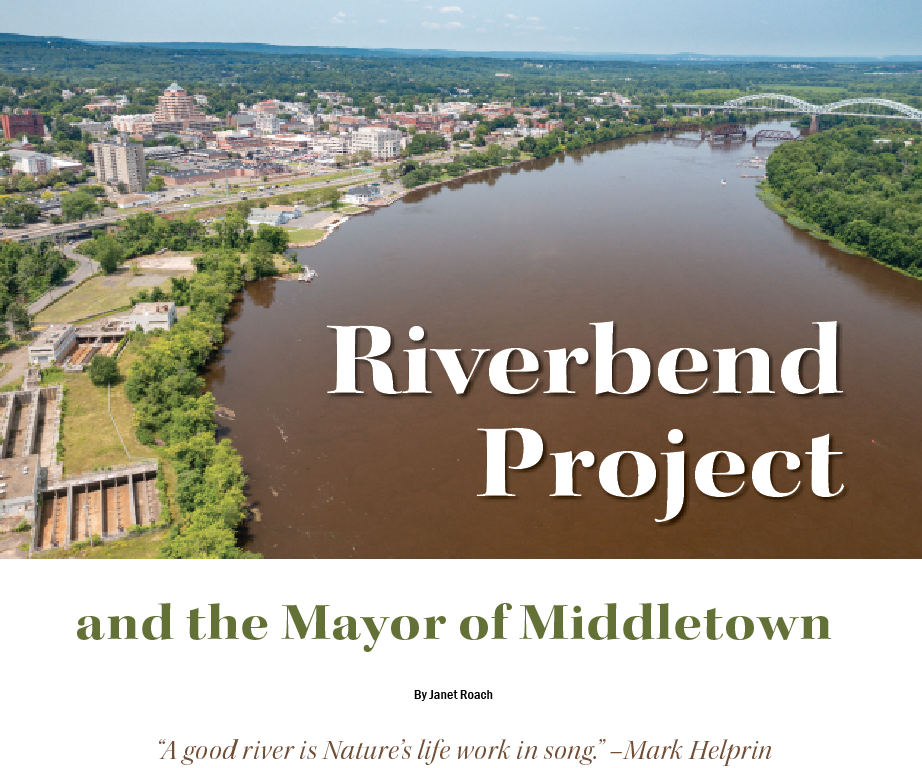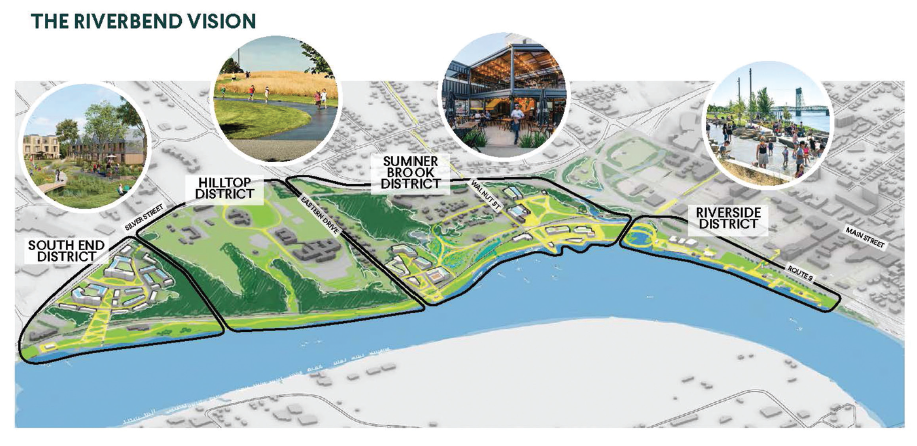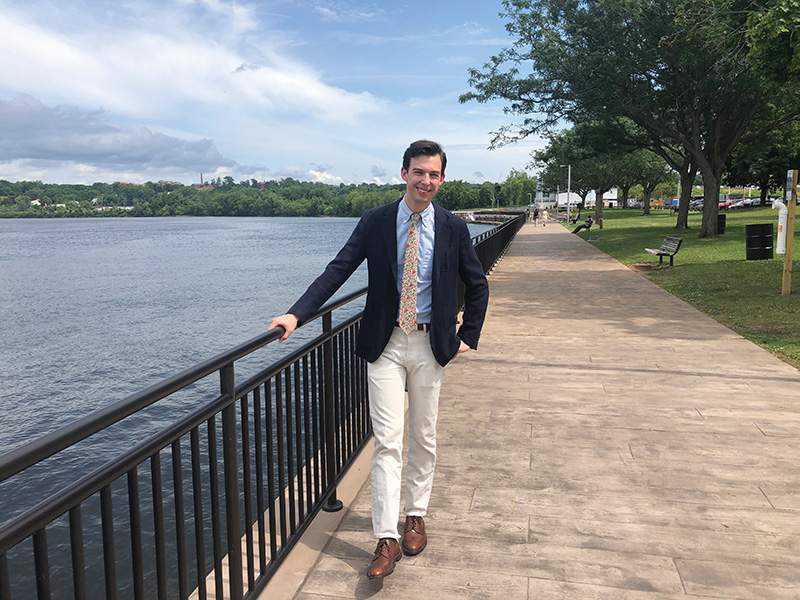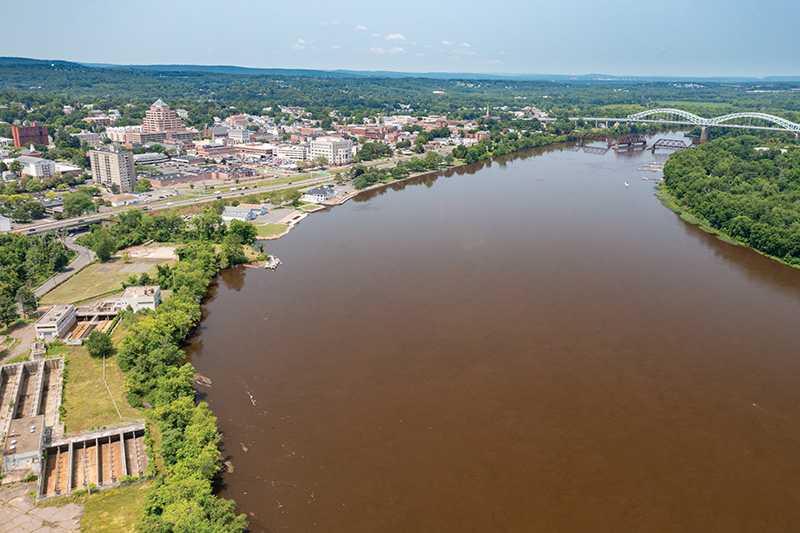
The river stank. For decades, towns, industries, and farms from Vermont to Long Island Sound had dumped vile and destructive wastes of every kind into her waters. So much so that, in 1969, Evan Hill, a professor of Journalism at the University of Connecticut, wrote in the New York Times, “Sometimes when its flow is low and it cannot properly dilute the waste man dumps into it, its attraction to the eyes is overbalanced by its repulsiveness to the nose.” Swimming, boating, and fishing had become rarities. Even the salmon had fled. The stench made riverfront property undesirable—an opportune place to build highways and railway tracks that physically partitioned humans from the river.
But that was then, and this is now. The public outcry over the river’s condition caught the attention of Connecticut’s then governor John Dempsey and Senator Abraham Ribicoff among others in the early 1960s. Extensive cleanup efforts were begun. It took nearly half a century, but in 2012 the US Department of Interior named the Connecticut River the first National Blueway. The Nature Conservancy dubbed it “one of the world’s last great places.”
Now the three largest cities along the Connecticut River are all making major efforts to reconnect their citizens to it. Springfield, Massachusetts, is entertaining a proposed $500 million 14-acre development on the riverbank that will include a new Roderick Ireland Courthouse, an 11-story apartment building, and a marina with restaurants and shops. Hartford is reconfiguring highways and revitalizing the riverfront. The website of Riverfront Recapture, a nonprofit, states that they have “transformed the riverfront from an overgrown area that was walled off by flood dikes and cut off by Interstate I-91 into four public parks connected by river walks.” The organization cites its Community Rowing Program as “one of the largest and most successful […] in New England.”

An artist rendering showing the revitalization concept shown to the City of Middletown in the Return to the Riverbend presentation by Cooper Roberston.
But perhaps the grandest undertaking is Middletown’s Return to the Riverbend. The multi-decade project entails redevelopment of 220 acres along two miles of riverfront. All intended to reconnect Middletown’s citizens and visitors to the Connecticut River.
Which brings us to Ben Florsheim, Middletown’s 32-year-old mayor and the chair of the steering committee charged with overseeing the realization of this visionary plan. Nearly three years of tilting with the windmill of the city’s endless needs, desires, and demands haven’t yet put the slightest streak of gray in his thick brown hair. And, yes, he wears Florsheim shoes; he is a descendant of the founder of Florsheim Shoes.
Florsheim takes no ownership of the Riverbend project. The city’s need to reconnect with the Connecticut River had been apparent since the four-lane Route 9 through town was completed in 1951, effectively severing Middletown from access to the river but for a sliver opposite downtown. Several efforts to remedy the situation faltered. Mayor Ben, as he likes to be known, attributes those failures to the fact that for many years Middletown mayors served only two-year terms—hardly long enough to get up a head of steam for such a complex undertaking. Still, ownership or no, under his leadership, Middletown at last has a master plan, complete with artists’ renderings of what’s to come.
The four-year term had just come into being when Florsheim decided to run. He’d come to love Middletown when he was at Wesleyan, got into local politics while he was a student, decided to stay after graduation, married his college sweetheart, and has since devoted his considerable intellectual and physical energy to constructing an enlightened future for the city, of which this multi-faceted project is a crucial element.

Ben Florsheim, Mayor of Middletown, CT. Image Credit: Dick Shriver
At a cost of $12 million, the city has already cleaned up two industrial sites and the former city wastewater treatment facility. In addition, the city has built a promenade along the river opposite downtown, and Middletown’s Garden Club has planted extensive gardens on the bank dividing the existing Harbor Park from Route 9. Murals are in the works for the existing tunnel between downtown and Harbor Park—all of which simply puts Mayor Ben and Middletown at the starting gate for the project.
“There’s wide consensus that this is the right thing to do,” says the mayor, adding that, since the Covid epidemic, Middletown has been attracting new residents interested in the city’s housing inventory—available at relatively low prices. A hip restaurant scene and the presence of his alma mater not far from downtown are added attractions. Riverbend, he believes, will bring long-needed financial as well as population growth to the city.
“The river is a tremendous underused asset,” he declares. “Once upon a time, Middletown was a prosperous shipping port.” Indeed. In the mid-1700s Middletown was the largest and one of the wealthiest towns in-state. “There were no roads,” adds Mayor Ben. “Hartford and Long Island were close because you could get to them by water. But Danbury was far away because there was no way to get there.”
The mayor hopes this project will “restore some of the city’s former luster” as well as become a “public recreation destination.”
The long-term vision for Riverbend is extensive. The Master Plan provides a four-part framework, starting with a broad esplanade over Route 9 to a renovated Harbor Park opposite downtown and extending southward past the big bend in the river that was once the shipping port and onward to the South End District, where mixed-income housing will one day rise.
The plan encompasses trails, a boat basin, a circular promenade out over the river, a nature center, a music and event venue, a skating rink, various restaurants and food stalls, boat slips and rentals, and a memorial plaza dedicated to the Wangunk indigenous people who once lived on the banks of the river.
What is all this to cost? The mayor laughs. He rattles off a torrent of figures, displaying an impressive command of the plan’s many components. He foresees raising funds from a slew of public and private sources. Altogether, what he conveys seems to constitute the financial equivalent of a Rubik’s Cube.
But already he has faced the realities of large-scale ambition. In March 2023, the Middletown Press reported that the renovation and repair costs for the former Mattabesett Canoe Club had risen from a 2021 estimate of $1.5 million to about $5 million—a rise of over 200 percent.
“There’s no sugar-coating that one,” admits the mayor, adding that the city-owned building is the lynchpin of Riverbend’s Phase I. But he resolutely declines to admit discouragement.
Mayor Ben acknowledges it’s not yet possible to predict the cost or time to fulfill the vision presented in the Master Plan. But it is his very firm intention to see that Return to the Riverbend gets off to a solid, momentum-creating start. “This,” he declares, his arm sweeping around from the river itself to the land encompassing Phase I, “cannot fail.”
“I’ve already made the decision to run for a second term,” he confides, drawing a very deep breath and adding that this is the kind of project that will remake Middletown in a lasting and important way, which is Mayor Florsheim’s highest hope for the project.
Says Connecticut’s Senator Chris Murphy, “There’s no one better suited to lead the Return to Riverbend project than Mayor Florsheim. I know this project well, and it’s a major undertaking. Success will require strong leadership and creative thinking to ensure this project spurs economic growth and benefits the community.”
So: significant challenges remain. But thanks to the efforts of many over the past half-century, the Connecticut River is no longer a smelly cesspool. In Middletown, the baton of leadership has passed to Mayor Ben. He wields it with vigor and high hopes that once again Middletown will be directly linked to the soul-soothing rhythm and beauty of the Connecticut River.

